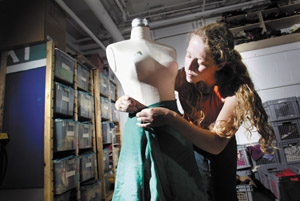 Setting
the scene
Setting
the scene
The
rhythmic clatter of presses and typesetting equipment that once filled the Cornell
Building are gone, replaced by the staccato pop of air nailers, the whine of table
saws, and the frying-bacon crackle of MIG welders.
This is the new University
Theater scene shop, where students have vastly increased opportunities to get
their hands on the backstage side of show business.

Costumer
Leah Marthinsen at work on the UT's Tempest project.
"We
were in a tiny, tiny little shop on the third floor of Mitchell Tower," says
Mark Lohman, the production manager of the University's student theater. "It
was a problem in a big way because we had no room to build and we couldn't work
during classes because of the noise." Scenery design was limited, and anyone
working on designs was condemned to lots of late-night and weekend work.
The
new shop features many large rooms, each stocked with tools and equipment and
devoted to a specific backstage craft: woodworking, metalworking, painting, electrical,
and costume/fabric-drop construction. Lohman-along with UT technical director
Dan Stearns, AB'91, AM'93, and their loyal student helpers-built several tool
cribs to protect the investment, and in the new wood shop they installed a raised
wood floor. A few inches above the original concrete, the floor allows them to
screw temporary assemblies into it and protects workers and tools from ricochets
off the concrete.
The Cornell building, at Cornell near 51st Street, became
available when the printing department moved to a larger space in the Back of
the Yards neighborhood in June 2001. "The facilities department knew we were
looking for new quarters for the shop," says Lohman, who managed the move's
logistics after UT director Heidi Coleman convinced the provost and dean it was
good idea. College dean John W. Boyer, AM'69, PhD'75, also lobbied for the new
shop and helped secure funding for renovation and tools. UT moved in August 2001,
and the old Mitchell Tower shop became a lighting-design studio and classroom.
Although an industrial-zoning designation means the building can't be
used as a classroom, it is something of a laboratory for students taking any of
35 undergraduate classes in theater, particularly five technical-theater classes.
In addition to solving scheduling and space problems, the shop offers students
more design and building opportunities, which in turns creates onstage possibilities.
Recent UT productions using the shop include The Bacchae, The Skin of
Our Teeth, and Edmund.
"The new facilities are so much
closer to a professional scene shop," says David Unger, AB'02, a technical
director on several UT shows. "The fact that you can now do so much more
technically will also open things creatively, which is another huge difference."
The quality of design and construction, notes UT director Coleman, has
also increased. "In our summer production of The Tempest, for example, we
have some students who are really talented painters, and the new shop gave them
the chance to transfer some Da Vinci sketches to large drops," says Coleman.
"Plus we can complete builds earlier, which means that rehearsals can be
done on the set, and that makes design a part of production and not a tacked-on,
last-minute thing."
A
quiet benefit of the new UT shop is that it has opened the eyes of many in the
University to the need for such facilities and the opportunities they offer-reinforcing
the plan to build a performing-arts center near Midway Studios. Notes Coleman:
"This will be a great way to experiment with things that we could do when
the arts center is built."
-Mark
Johnson, AB'83

![]()
 Setting
the scene
Setting
the scene